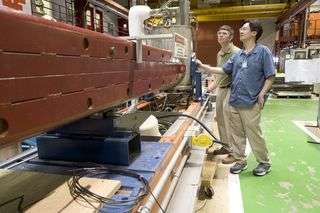March 3, 2008 feature
Is dark matter made of axions?

One of the mysteries of our universe is that of dark energy and matter. Scientists all over the world are attempting to discover what particles make up dark energy and matter. “Axions are one of the particles considered for dark matter,” William Wester tells PhysOrg.com. “We were hoping to get a signal proving that they exist with this experiment.”
Wester, a scientist at the Fermi National Accelerator Laboratory (Fermilab) in Batavia, Illinois, worked closely with Aaron Chou, now at New York University, and a group of scientists from Fermilab and the University of Michigan in Ann Arbor, to design an experiment to test the existence of axion-like particles within a certain range. Their results can be found in Physical Review Letters: “Search for Axionlike Particles Using a Variable-Baseline Photon-Regeneration Technique.”
Axions are hypothetical particles that have a small mass in the milli-electronvolt (eV) range, making them 500 million times lighter than an electron. Additionally, an axion should have no spin.
“Normally,” Chou points out, “we can only detect these kinds of particles with telescopes, looking out into space. And then it is only an indirect detection.” The idea was to create conditions allowing them to detect particles in the milli-eV range during a lab experiment.
“For particles that interact strongly enough for us to detect, there are constraints on where they could exist or not,” Chou continues. “For the specific region of our experiment, no one would have thought to look into it without the PVLAS experiment.”
Wester explains that the PVLAS collaboration did an experiment in which a signal that could have been an axion was detected. “We wanted to see if we could get the same results,” he says. The PVLAS experimenters eventually ruled out the signal after Wester and Chou started to work with their peers on this experiment. However, there were still some innovations that encouraged the Fermilab group to move forward.
“We set things up a little differently,” Wester says. He points out that the Tevatron magnets used in the Fermilab experiment were stronger and better suited for experiments in the milli-eV range than those used in previous experiments. With the magnetic field in place, a laser was aimed down the middle.
A “wall” was placed in the middle of the magnetic field as well. The magnetic field would possibly change some of the photons from the laser into axions. The wall would stop the photons, but the axions would emerge on the other side.
“There were four different configurations,” Wester continues. “We also had the blocking mechanism placed off to the side to change the effective length of the magnetic field. We also did it with two different polarizations, vertical and horizontal.”
Wester says that, unfortunately, the experiment found “no evidence of new particles.” But, he insists, “It turns out we’re able to exclude any possible particle of this type a little more stringently. It extended the region to be excluded.”
Chou thinks that maybe, with a stronger magnetic field, it might be worth re-exploring this region. “The effect we are looking for gets stronger as the magnetic field does.”
Both scientists are interested in the future possibilities. “There is a proposal out there that involves putting very precisely controlled optical cavities before and after the wall, and using stronger and longer magnets,” Wester explains.
Chou also points out that the data from the Fermilab experiment is still being examined. “There is speculation about particles called chameleons, which take on the properties of their environments.” These chameleon particles would have a small mass in low energy density, and large mass in environments of high energy density. “We are continuing analysis to see if maybe we can find a chameleon particle.”
In the search for dark matter particles, Wester is optimistic about the role he and his colleagues are playing. “We did a serious measurement and excluded a region,” he says. “If our small experiment helps heighten awareness and leads to more experimental efforts, even using other techniques as well, it will be a huge benefit that we have done this.”
Find out more about the Fermi Lab experiment by visiting gammev.fnal.gov .
Copyright 2007 PhysOrg.com.
All rights reserved. This material may not be published, broadcast, rewritten or redistributed in whole or part without the express written permission of PhysOrg.com.



















